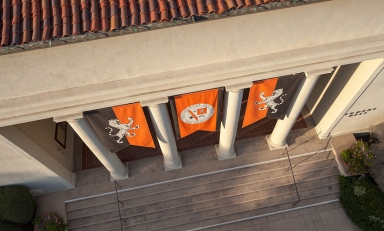As a student, Kristi Upson-Saia traveled to Florence and Heidelberg to study art history.
Seeing Renaissance art and architecture in person gave her an appreciation of Italian and German history and culture she wouldn’t have had just by reading books or attending lectures.
The Occidental College assistant religious studies professor wanted her students to have a similar experience. Why not create a course in which students are introduced to a country, she mused, then continue their studies by actually exploring that country without spending an entire semester overseas?
"There’s something about embodying the knowledge that to me is more meaningful and complex than what you can do in a classroom," said Upson-Saia. "So I wanted to give it a try."
This spring, she did just that. She chose Turkey, a country that straddles Eastern and Western cultures and which boasts more Greek ruins than Greece and more Roman archaeological sites than Italy. The country, bordered by Syria and Iraq in the south and Bulgaria, Greece and the Black Sea in the north and west, also contains many Christian, Jewish and Muslim sites, and remnants of early Greek civilization, Byzantine majesty, and Ottoman culture and artistry.
Entry into the course, titled "Turkey: Then & Now," was competitive. Forty students applied and 13 made the cut. They had varied backgrounds and interests, with majors ranging from religious studies and diplomacy and world affairs, to kinesiology, physics and film.
Each had expressed a focused interest in one or more aspects of Turkish culture. That way, Upson-Saia said, they could contribute to the group’s multi-faceted understanding of Turkey.
"I had a great group of students I could trust to conduct independent research and to convey not only accurate information, but to also analyze their topic in a sophisticated way," said Upson-Saia. "This was not a cakewalk."
During the semester, the class met once a week to study the Greeks and Persians of the classical period, the Romans, Christians from the late antiquity and Byzantium, the Turks of the Ottoman period, and the modern Turkish Republic. Students also participated in extracurricular activities, such as eating dinner with local Turkish-Americans at a Turkish restaurant, screening Turkish films, and making glass mosaics.
The course was capped by a 17-day trip to Turkey, where the students gave final research presentations at historical sites on topics ranging from the region’s earthquake-prone geology to the Armenian genocide of 1915. The trip started and ended in Istanbul (the former Constantinople). In this ancient city, Upson-Saia, the students and a Turkish guide saw the famed Hagia Sophia, once a mosque and now a museum, the Blue Mosque and the Topkapi Palace, a sprawling complex where the Ottoman sultans resided for 600 years.
The group also traveled to other parts of the country. They explored the lunar-like landscape of Cappodocia, the site of early Christian churches and monasteries carved from rock, took a walking tour of Antalya’s Old City, and enjoyed a boat cruise down the Anatolian coast, where they swam in the warm Mediterranean.
For the students, these up-close and personal experiences made their academic learning come alive. DWA major Sarah Richey ’10, said that during the trip, she wasn’t just a student, but also "a culinary critic, an art collector, a nature lover … and a potential diplomat."
"The academic snapshot I had of Turkey from a semester of readings and handouts expanded into a fully three-dimensional experience," Richey wrote in a paper giving her final reflections of the class. "I connected to the country in ways I did not expect ... the richest learning occurs when I am able to meld my personal context with new, intellectual discoveries."
Religious-studies major Jeff Eamon ’11 said he was impressed not just by the country’s historic and beautiful architecture, but that it was available to everyone.
"In Turkey, you can go right up and touch old monuments. You can still see and feel today what was built by Constantine, Justinian and a lot of the Ottoman sultans," he said. "In the U.S., these historical structures would have been roped off and behind glass."
For Upson-Saia, her discussions with students and among the students themselves, often sparked by visits to historical sites or over meals, enriched their learning in ways not possible in the classroom. She hopes that other Oxy professors will teach similar short-term study-abroad courses, and would like to take a group of Oxy alumni on a future trip to help defray student costs for these types of courses.
"One highlight was the conversations we had. In the classroom, you only have 50 minutes or an hour and a half. But in this 17-day structure, you can come back to conversations again and again," she said. "The space made on bus rides and over meals for these sustained conversations made them so much more complex. That to me was the luxury of this sort of program."



